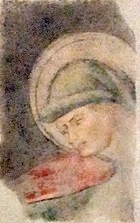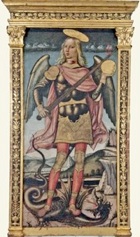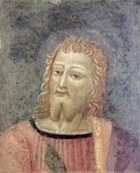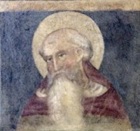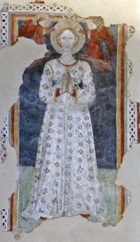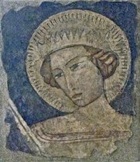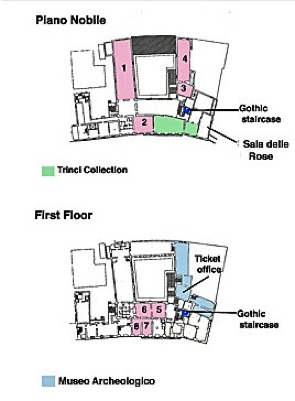
The art gallery is laid out in eight rooms in Palazzo Trinci:
-
✴The rooms that I have labelled 1-4 are on the on the piano nobile. After buying your ticket, walk up the wooden steps behind you and to the left and continue up the Gothic staircase to the piano nobile above.
-
✴The rooms that I have labelled 5-8 are on the first floor, near the ticket office and the Gothic staircase.
The works of art are identified below by their gallery numbers (where these are assigned). They are listed in the order in which they were exhibited in 2016.
Room 1
27. Martyrdom of St Barbara (1449)
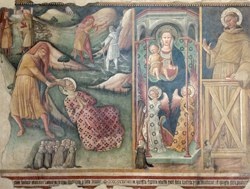
This composite fresco from Santa Caterina Vecchia, which is signed by Bartolomeo di Tommaso and dated, was probably commissioned in thanks for the delivery of the city (or perhaps the donor) from the plague. It was detached in 1873.
-
✴In the main scene, Santa Barbara is scalped and a group of kneeling nuns bear witness while shepherds survey a plague of locusts in the background.
-
✴The subsidiary scenes depict:
-
•the Madonna di Loreto with angels; and
-
•St Antony of Padua.
-
In each of these, a single kneeling nun (presumably the donor) says her rosary.
37. Coronation of the Virgin (1486)
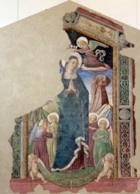
28. Madonna and Child and saints (late 15th century)
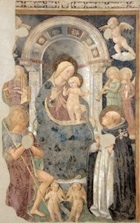
29. Madonna and Child with St Simon (late 15th century)
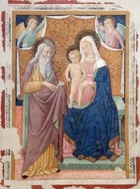
30. Crucifixion with saints (late 15th century)
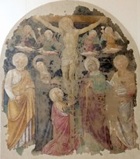
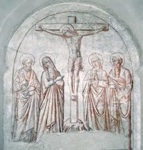
Sinopie, in situ
This damaged detached fresco, which is attributed to Pierantonio Mezzastris, came from the chapel to the right of the presbytery in San Domenico. It depicts the Crucifixion with the Virgin and SS John the Evangelist, Peter, Paul and the kneeling Mary Magdalene. The sinopie survives in the original location; the figures of St Mary Magdalene and of the four angels in the fresco do not appear in it, which suggests that they were later additions.
31. St Jerome as cardinal and as penitent (late 15th century)
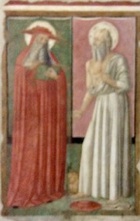
Un-numbered: Pietà (15th century)
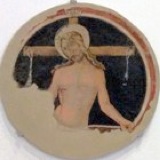
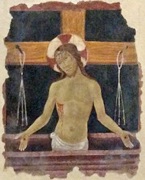
The gallery displays these two panels together:
-
✴The round panel on the left was apparently detached from Palazzo Barnabò.
-
✴This fresco on the right, which depicts a half-length figure of Christ emerging from the tomb, with His wounds displayed and the instruments of the Passion to the sides, came from the Ospedale Vecchio di San Giovanni Battista.
34. Madonna and Child with saints (late 15th century)
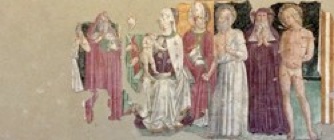
This detached fresco, which is attributed to Pierantonio Mezzastris, came from the Chapter Room of San Francesco. It depicts the Madonna and Child with:
-
✴a lost saint, a fragment of Blessed Peter Crisci, St Jerome as a cardinal and St Catherine of Alexandria on the right; and
-
✴SS Blaise, Jerome as a penitent, Bonaventure and Sebastian on the left.
35. Angel of the Annunciation (late 15th century)
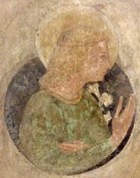
Un-numbered: Head of a Knight (15th century)
36. Madonna and Child with saints (1499)
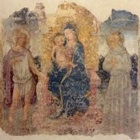
Un-numbered: Annunciation (15th century)
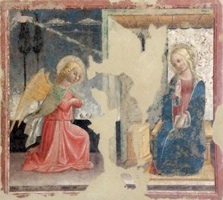
This fresco from a house in Via Piermarini is attributed to Nicolò di Liberatore, l’ Alunno.
40. Stigmatisation of St Francis (15th century)
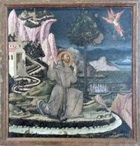
41 Predella panels (1491)

These panels formed the predella of a documented altarpiece from Santa Maria delle Grazie, Todi, which was sold in the 19th century. The main panel, which has been lost, apparently depicted a Pietà with the Virgin and St John the Evangelist. The Commune of Foligno bought the predella panels in 1950.
The surviving documentation includes a receipt signed by Nicolò di Liberatore, l’ Alunno in 1493, acknowledging payment by the Confraternita di Santa Maria delle Grazie for an altarpiece for their church. Nicolò wrote to the brothers in 1494, expressing his intention to return to Todi when it was “free from plague and other tribulations”. It seems that he never returned: in 1504, Lattanzio di Nicolò gave the brothers a receipt for 21 days’ work that he had done while his father was alive (i.e. before 1502), and a bill for subsequent work for the gilding of a tabernacle in the church.
The main panel of the predella depicts for prophets set against a landscape that is reminiscent of the plain of Foligno. The other two panels depict angels holding inscriptions:
-
✴that on the left includes the inscription "Nicolaus Fulginas pinxit: Lattantius filius i(n)auravit" ((Nicholas painted it: his son, Lattanzio gilded it); and
-
✴that on the right gives the date 1491.
Un-numbered: St Michael (late 15th century)
43. St Roch (1497)
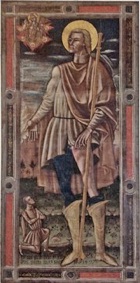
Un-numbered: Gonfalone di San Vitale (15th century)
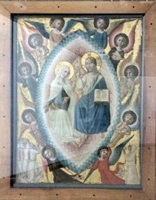
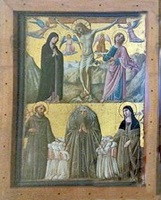
This double-sided standard, which is attributed to Pietro di Giovanni Mazzaforte, came from Oratorio di San Vitale, Assisi.
-
✴On one side, the Virgin commends members of the confraternity (three men knelling at the lower left and a woman kneeling at the lower right) to Christ, who confers his blessing. Both Christ and the Virgin are in a mandorla supported by angels.
-
✴The other side depicts:
-
•the Crucifixion with the Virgin and St John the Evangelist (above); and
-
•the Blessed Vitale surrounded by the kneeling brothers, with SS Francis and Clare. (The Blessed Vitale was a hermit who founded the confraternity in ca. 1362 on Mount Subasio.)
66. Madonna and Child (15th century)
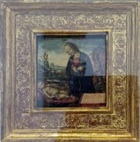
Un-numbered: Madonna and Child (15th century)
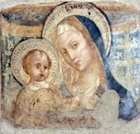
Un-numbered: Pietà with angels (15th century)
This dark panel, which belongs to the Cassa di Risparmio di Foligno, is attributed to Nicolò di Liberatore, l’ Alunno.
Room 2
17. St Catherine of Alexandria (early 15th century)
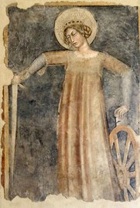
18. Annunciation (ca. 1420)
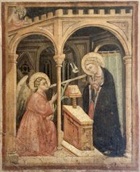
19. Madonna del Latte (early 15th century)
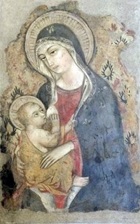
21. Way to Calvary (15th century)
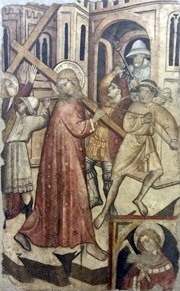
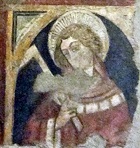
Detail (enlarged)
This fresco is attributed to Giovanni di Corraduccio Mazzaforte. The Pinacoteca includes it among those from San Giovanni Decollato, but the presence of an image of St Claudius (with a set square) in the lower right-hand corner suggests (at least to me) that it came from San Claudio.
Un-numbered: Scene from Life of St Benedict (15th century)
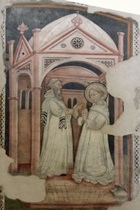
23-5. Frescoes from San Giovanni Decollato (ca. 1428)
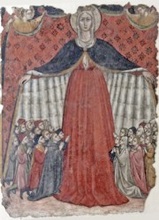
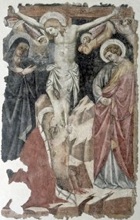
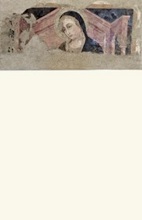
These detached frescoes, which are attributed to Giovanni di Corraduccio Mazzaforte, were detached in 1869 when San Giovanni Decollato was demolished. They include (from left to right above):
-
✴the Madonna della Misericordia (23);
-
✴the Crucifixion with the Virgin and SS John the Baptist and Mary Magdalene (24); and
-
✴a fragment of a the Madonna and Child (25).
Un-numbered: Madonna and Child (14th century)
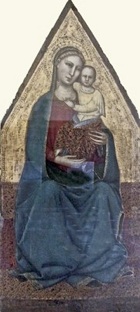
Room 3
45. Madonna di Loreto and Pietà (1494)
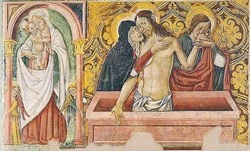
This detached fresco, which is attributed to Ugolino di Gisberto and dated by inscription, is of unknown provenance.
47. Madonna and Child with angels (15th century)
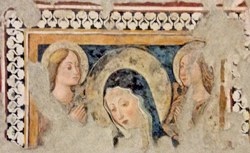
Only the upper part of this detached fresco from the church of the Ospedale Vecchio di San Giovanni Battista survives. It is attributed to Ugolino di Gisberto.
Un-numbered: Madonna and Child enthroned (1491)
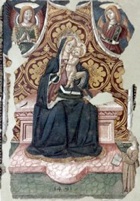
Un-numbered: Madonna and Child (15th century)
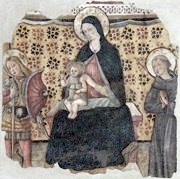
This detached fresco, which is attributed to Ugolino di Gisberto, was discovered in Palazzo Barnabò in Piazza XX Settembre in 1908. It depicts the Madonna and Child with SS Michael and Francis. The baby Jesus lifts His tunic to show his genitals, presumably to emphasise his humanity.
Room 4
52. View of Foligno (1602)

Michele Faloci Pulignani documented and illustrated this long panel in his guide to Foligno (1907), when it was “near the parish church at Cave [di Foligno]”. He recorded that Ascensidonio Spacca, il Fantino had painted it in 1602. It depicts the view of the city from Porta Romana in the 17th century. Two features of it support the reported date of 1602:
-
✴the arms of Pope Clement VIII (1592-1605) can be seen on Porta Romana; and
-
✴it also depicts the cupola of the Duomo, which was completed in 1602.
This panel was documented again in 1913 as one of three works that il Fantino had executed in Foligno: the other two depicted:
-
✴the Madonna of the Rosary; and
-
✴St Antony [of Padua ?] and scenes from his life.
Emanuela Cecconelli (referenced below, at pp. 362-6) associated the former with a documented but now lost panel (1602) by il Fantino from the Cappella del Rosario of San Domenico, which depicted the Madonna of the Rosary and SS Dominic and Catherine of Alexandria. She suggested that this lost panel of the Madonna of the Rosary and the surviving panel of a view of Foligno originally formed a single work in the Cappella del Rosario of San Domenico.
53. Copy of the Foligno Madonna (1838)
This copy of the panel (1511) by painted by Raphael is signed by Enrico Bartolomeo and dated by inscription. It was painted some 23 years after the nuns of the Monastero di Sant' Anna sold the original to Pope Pius VII.
54. Madonna and Child with saints (early 16th century)
This fresco, which is attributed to Feliciano de’ Muti, came from the nunnery of Sant’ Anna. It depicts the Madonna and Child enthroned with the young St John the Baptist and SS Francis and Antony of Padua.
55. St Amicus (1508)
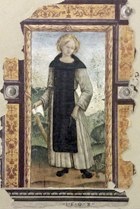
56. Pietà with saints (1543)
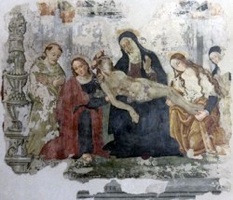
This dated fresco of the Pieta with the Virgin and SS Francis, John the Evangelist and Clare is from the nunnery of San Claudio.
57. St Augustine (early 16th century)
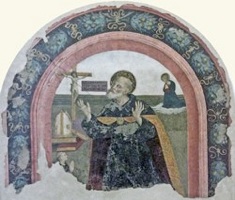
This detached fresco, which is attributed to Lattanzio di Nicolò, came from the nunnery of Sant’ Elisabetta (later in Santa Margherita). It depicts St Augustine in prayer before a Crucifix, with a kneeling monk, presumably the donor.
58. Madonna and Child Enthroned (16th century)
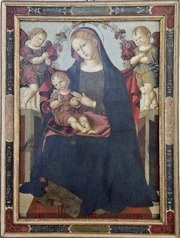
61. St Bartholomew (early 16th century)
62. Martyrdom of St Catherine of Alexandria (16th century)
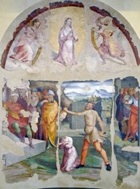
67. Nativity (16th century)

This fresco fragment, which depicts the baby Jesus lying in a meadow, came from the Ospedale Vecchio di San Giovanni Battista.
Room 5
14. St Antony Abbot (early 15th century)
15. Coronation of the Virgin (early 15th century)
16. Fresco fragments (late 14th century)
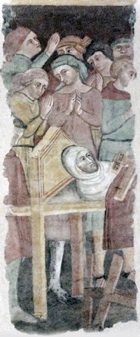
-
✴a scene from the life of St Elizabeth of Hungary (exhibited 8 in Room 8 below);
-
✴a scene from the legend of the verification of the True Cross in which the relic restored a dead person to life (exhibit 16, illustrated here); and
-
✴Christ in the house of Mary and Martha (exhibited 7 in Room 8 below).
Room 6
9-11. Frescoes from San Claudio (late 14th century)
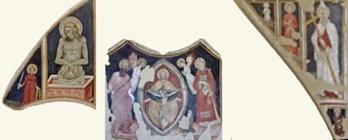
These detached frescoes San Claudio include:
-
✴a Pietà, with St Catherine of Alexandria to the left (9);
-
✴a representation of the Trinity in a mandorla with SS Paul and Lawrence and two angels (10); and
-
✴St Helen holding the True Cross, with smaller figures of SS Margaret and an unknown female saint to the left and the kneeling St Jerome below (11).
12. Fresco fragment (late 14th century)
Room 7 and 8
1-6. Scenes from the Passion (late 14th century)
These frescoes, which are attributed to the Maestro dell' Abside Destra di San Francesco di Montefalco, were discovered in 1909 during the demolition of part of the ex-nunnery of Sant’ Elisabetta, which was then known as Santa Margherita. They depict:
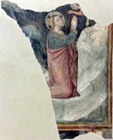
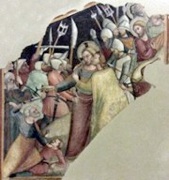

-
✴Christ in the garden (1);
-
✴the capture of Christ, in which Judas kisses Christ as He warns Peter not to throttle one of His captors (2);
-
✴the way to Calvary (3) of which only the upper part survives;
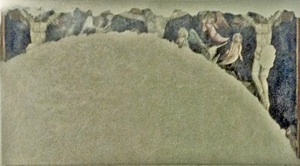
-
✴the Crucifixion of Christ and the two robbers (4), of which only the upper part survives;
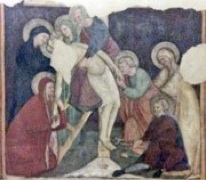
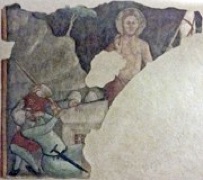
-
✴the Deposition (5); and
-
✴the Resurrection (6).
7 - 8. Fresco fragments (late 14th century)
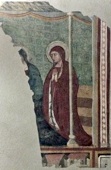
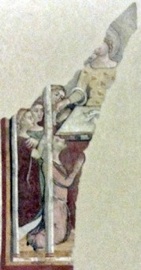
Three fragments were found in 1910 in the ex-nunnery of Sant’ Elisabetta, which was then known as Santa Margherita. They are attributed to the Maestro dell' Abside Destra di San Francesco di Montefalco. According to Emanuela Cecconelli (referenced below, at p. 378), they depicted;
-
✴Christ in the house of Mary and Martha (7);
-
✴a scene from the legend of the verification of the True Cross in which the relic restored a dead person to life (exhibit 16 in Room 5, above); and
-
✴a scene from the life of St Elizabeth of Hungary, in which she distributes out what seem to be small scrolls to a number of young women (8).
Read more:
E. Cecconelli, “Ascensidonio Spacca a Foligno: Sulle Tracce di due Opere dell' Artista Bevanate”, Bollettino Storico della Città di Foligno, 37 (2014) 361-98
Return to Palazzo Trinci.
Return to the page on Museums of Foligno.
Return to Walk II.


